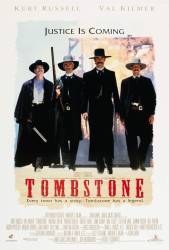Factual error: In the scene just before the fight at the O.K. Corral, Wyatt is talking to his brothers and Doc on the porch of the town marshal's office. There is an American flag flying behind him with 50 stars on it when in fact there were only 38 stars on the flag in 1881.
Factual error: Three of the Earp brothers arrived in Tombstone on December 1, 1879. They served as lawmen during 1880/81 and fought the Cowboys in the famous gunfight on October 26, 1881, They left the area in April 1882. In the movie the Earps arrive in Tombstone in 1881 and ride past Boot Hill Cemetery. The tombstone displaying one of the most famous epitaph ever written is visible: "Here lies Lester Moore, Four slugs from a .44, No Les, No more." The problem is that Lester Moore wasn't killed until 1884. So it's impossible for his tombstone and famous epitaph to be in Boot Hill when the Earps arrived.
Suggested correction: Fact is nobody knows who Lester Moore is. They believe he was a mail clerk who was shot and killed over a dispute over a package, but they cannot prove it. There is no date on the tombstone, plus the fact that there was never anyone by that name ever killed in the Arizona territory makes this tombstone even more mysterious.
Factual error: When the Earps first arrive in Tombstone (in 1880), they go past the Bird Cage Theater, which wasn't built until 1881.
Factual error: During the gunfight in the lot behind the OK Corral, Tom McLaury is firing a six shooter at Doc just before Doc fires his shotgun in the air to scare Tom's horse away. The mistake is that Tom McLaury wasn't armed during the actual gunfight. He was shot by Doc while he was reaching for the rifle he had stored in his saddle. (01:14:58)
Suggested correction: The events have been intentionally adjusted by the filmmakers to create a coherent and entertaining movie. It is not a documentary. This film is loosely based on true events; it's not a day-to-day account of the events of 1880 through 1882. Artistic license does not constitute a movie mistake.
Changing facts in historical material does constitute factual mistakes, whether anybody wants to call them that or not.
It really depends on the degree to which the film-maker alters the facts, and whether that alteration is glaring or changes the story line. For most, it doesn't. Tom got shot and Doc shot him. There is an implicit duty of the audience to "suspend disbelief" - an acknowledgment that it is impossible to get every small detail correct.
How does changing the facts make it a good movie? I guess it might entertain those who know nothing about the facts. But for those who have studied and read up on things, going way out of the story does little in making a good story. That is why I like "Wyatt Earp" MUCH more than "Tombstone." No, "Wyatt Earp" is not a documentary. It, too, has altered some facts. But, to me, it is much closer to the truth. Even some of the dialog is from the Tombstone Epitaphs reporting of the incident.
Factual error: In the scene when Virgil returns to the Oriental after being shot, Wyatt and Morgan are sitting at a table eating Chinese noodles with vegetables, among which is broccoli. Broccoli was practically unknown in the United States until it began to be commercially cultivated in California in the 1920s.
Factual error: When Doc is playing poker with Ed Bailey and Doc lays his guns on the table, in the middle of the table is the reverse (back) of a Washington quarter. These type of Washington quarters began being minted in 1932.
Factual error: At the end of the movie, the narrator says that Ike Clanton was shot and killed during an attempted bank robbery. Ike Clanton was actually killed while attempting to flee from Detective Jonas Brighton who was sent to arrest him for the crime of cattle-rustling.
Factual error: Billy Breakenridge in real life was a large man who was almost certainly not gay. He certainly wasn't effeminate as the film makes him out to be and he was known as a good shot and a tough individual.





